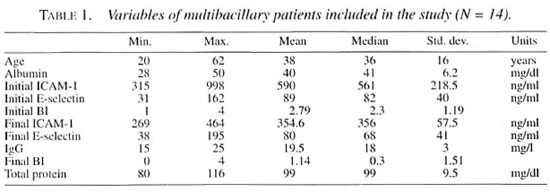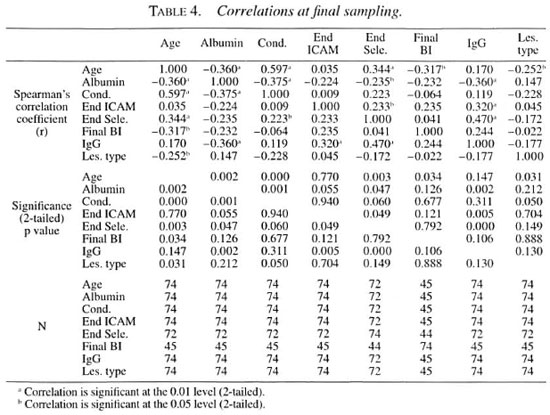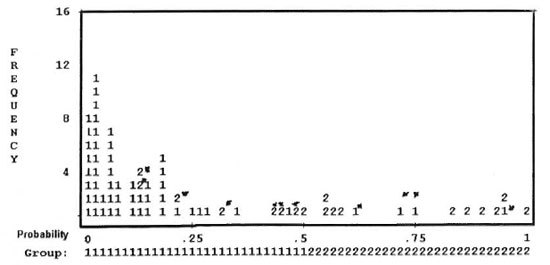- Volume 67 , Number 1
- Page: 19–23
Serum markers of treatment success in leprosy
ABSTRACT
Intercellular adhesion molecule-1 (ICAM- 1) and E-selectin and other variables were evaluated as possible markers of the success of multidrug therapy (MDT) in leprosy. Multibacillary (MB, N = 45) and paucibacillary (PB, N = 29) leprosy patients were examined during MDT, which typically lasted 12 months for MB and 6 months for PB patients. Serum values for total protein, albumin, immunoglobulin gamma (IgG), ICAM-1, and E-selectin (selectin) were recorded, as were lesion type, number, and distribution. Response at the end of therapy was assessed as good, fair, or poor. The bacterial index (BI) of lesions was measured at the beginning and end of therapy. The earlier reported findings of this investigation are herein re-examined. Results: age and lowered serum albumin correlated with the poorer condition of the patients, as did elevated selectin. Albumin was inversely correlated with the BI (p = 0.008) in MB patients, and IgG was positively correlated (p = 0.009). ICAM and E-selectin alone were not useful markers of individual patient condition. A regression combining serum albumin under 41 g/I, age and E-selectin was able to identify 85% of the patients in poorer condition. Conclusion: serum albumin was a useful nonspecific marker of both patient condition and infection. Age is an important negative factor in patient response. Albumin and IgG correlate with the BI and with each other (p = 0.011) in MB patients, but not in PB patients.RÉSUMÉ
Les molécules d'adhésion intercellulaire de type 1 (ICAM-i), les sélectines E et d'autres variables ont été évaluées en tant que marqueurs potentiels de réponse à la polychimiothérapie (PCT) efficace contre la lèpre. Des patients atteints de lèpre multibacillaire (MB, N = 45) et paucibacillaire (PB. N = 29) ont été examinés pendant leurs PCT, laquelle dura environ 12 mois pour les patients MB et 6 mois pour les patients PB. Il fut enregistré, à partir du sérum, les valeurs des protéines totales, de l'albumine, des immunoglobulines gamma (IgG), des 1CAM-1 et des sélectines E, de même que le type, le nombre et la distribution des lésions. La réponse en fin de traitement fut estimée comme bonne, adéquate ou mauvaise. L'indice bactéridien (IB) des lésions fut mesuré au début et à la fin du traitement. Les premières données rapportées à partir de cette étude sont ré-éxaminées ici. Résultats: l'âge et une albumine sérique basse étaient corrélés avec un mauvais état général du patient, comme l'indiquait également une quantité élevée de sélectine. Chez les patients MB, l'albumine était inversement corrélée avec l'IB (p = 0,008), et la quantité d'IgG était positivement corrélée avec l'IB (p = 0.009). Les ICAM-1 et les sélectines E. isolées, n'étaient pas de bon indicateurs de l'état général des patient à l'échelle individuelle. Une régression combinant une albumine sérique de moins de 41 g/1, l'âge et les sélectines E fut capable d'identifier 85% des patients avec un mauvais état général. Conclusion: l'albumine sérique est un marqueur non-spécifique utile à la fois pour prédire l'état général et l'infection du patient. L'âge est un facteur négatif important pour prédire la réponse au traitement du patient. L'albumine et les IgG corrèlent avec l'IB et entre eux (p = 0.011 ) chez les patients MB, mais pas chez les patients PB.RESUMEN
Se evaluaron las moléculas de adhesion intercclular (ICAM-1) y las selectinas E como posibles marcadores del éxito de la poliquimioterapia (PQT) en la lepra. Los pacientes con lepra multibacilar (MB, N = 45) o paucibacilar (PB. N = 29) se examinaron durante la PQT, la cual fue de 12 meses para los pacientes MB y de 6 meses para los PB. Se registraron los valores de proteínas totales en el suero, de albumina, de inmunoglobulina gamma (IgG), de ICAM-1, y de selectina E, así como el número, tipo y distribución de las lesiones. La respuesta al final del tratamiento se calificó como buena, regular, o pobre. El índice bacteriano (BI) de las lesiones se midió al inicio y al final de la PQT. Resultados: la edad avanzada y los niveles bajos de albumina correlacionaron con la pobre condición de los pacientes; esto también ocurrió con los niveles elevados de selectina. La albúmina correlaciono en forma inversa con el BI (p = 0.008) en los pacientes MB, y la IgG correlaciono positivamente (p = 0.009). Los niveles de ICAM-1 y de selectina E, solos, no fueron marcadores utiles de la condición individual dc los pacientes. Una regresión, combinando los niveles de albúmina por debajo de 41 g/l, la edad y los niveles de selectina E, permitió identificar al 85% de los pacientes en la condición más déplorable. Conclusion: la albúmina dei suero lue un marcador no específico útil para establecer tanto la condición de los pacientes como la infección. La edad es un importante factor negativo en la respuesta de los pacientes. La albúmina y la IgG correlacionai) con cl B1 y entre si (p = 0.011 ) en los pacientes MB pero no en los pacientes PB.The diagnosis of leprosy is usually based on clinical examination, supplemented by histology. There are two polar forms of the disease, with various less stable stages between the polar forms. At the tuberculoid (TT) pole, cell-mediated immunity (CMI) is strong and there are few bacilli found in the lesions. At the lepromatous pole, CMI is very weak and there are many widely dispersed bacilli. The World Health Organization (WHO) recommends that leprosy be classified as either paucibacillary (PB) or multibacillary (MB).
The bacterial index (BI) counts the bacilli microscopically observed in smears taken from patients. The test results vary with the technicians involved, and bacilli are usually not seen in PB cases. Consequently, a more reliable way of monitoring treatment success is desirable. A recent article (3) suggested that serum intracellular adhesion molecule-1 (ICAM-1) and E-selectin might be useful for monitoring leprosy treatment. We herein re-examine the data used by the authors of that article, and evaluate additional variables from the same frozen serum.
PATIENTS AND METHODS
New patients presenting to the urban Bombay Leprosy Project treatment center, Mumbai, India, were selected for study. Informed consent was obtained from each patient. There were 20 women and 54 men. The mean age was 36 years (range 10-80), distributed normally except for peaks in the 20-25-year-old age group; PB patients averaged about 10 years younger than MB patients. There were 45 MB patients for 14 of whom the initial values were available (Table 1), 29 PB for 11 of whom initial values were available (Table 2), and 15 uninfected controls (Table 3). Duration of therapy was usually 6 months for PB and 12 months for MB patients. All patients had serum samples taken before treatment and after 1 month of MDT. MB patients received 600 mg rifampin and 50 mg clofazimine monthly under supervision, with a daily self-administered 100 mg dose of dapsone and 50 mg of clofazimine. PB patients received 600 mg rifampin per month and 100 mg of dapsone daily. Reactions were treated with tapering doses of steroids, starting at 60 mg.



Recorded data included: condition (response) on completion as good (N = 56), fair (N = 17), or poor (N = 1), these being personal subjective assessments by experienced leprologists of the response to treatment compared to the normal response; the number of lesions, their distribution and type; the initial and final BI; date and type of any reaction, and final total serum protein, albumin, IgG, ICAM-1 and E-selectin. For 25 patients, the initial values of ICAM and other variables were used; for the others, only final results were available. Clinical and histological examinations were performed in Mumbai, India, and serum was examined using standard methods in the specialized Neurochemical Laboratory, Department of Neurology, University Hospital, Gottingen, Germany. Statistical analyses were performed using the Statistical Programs for the Social Sciences (SPSS version 6) programs, (SPSS, Chicago).
RESULTS
Poorer patient response was correlated with age (r = 0.632, p <0.01) and lowered albumin (r = 0.427, p <0.01). Albumin values below 41 g/1 were especially associated with poorer patient condition. When corrected for age, the correlation of albumin with condition was still significant (r = 0.25, p = 0.035). Table 4 shows the correlations of the variables. A discrimination function using the variables of age, albumin and E-selectin was able to identify 93% of the patients in good condition and 65% of those in poor condition. When ICAM was substituted for selectin in the regression, discriminating ability for patients in poor condition dropped about 5%. A logistic regression which considered age, E-selectin and albumin of <41 g/1 identified 85% of the patients in poorer condition (p = 0.003). In MB patients, the IgG correlated with the BI (p = 0.014) and inversely with albumin (p = 0.011); lowered albumin correlated weakly with the BI (p = 0.06). With PB patients, these correlations were not significant. All PB patients had a final BI of zero.

The Figure shows the predicted probability of the patients having a fair or poor response after treatment according to a joint regression of age, albumin and E-selectin (with no cut-off level). Note that 7 patients of 72 were misclassified despite high probabilities. For the individual regressions, response correlated (r = 0.6) with age, with albumin (r = -0.37), and with E-selectin (r = 0.28, p = 0.06).

The: Figure. Prediction of condition hy logistic regression of age, albumin and E-selectin at the end of treatment; observed groups and predicted probabilities. * = Predicted probability is for memhership in group 2 (less than good condition).
DISCUSSION
The difference in age between the PB and MB groups may tend to confound the influence of age and type of disease. Both albumin and IgG are nonspecific findings, so their use as a specific measure of disease status in leprosy is not warranted. However, the clinician may find them useful in the absence of more specific mensures.
A T cell which has been previously exposed to a specific antigen may cause the release of tumor necrosis factor-alpha (TNF-α) and chemoattractants when it again encounters the antigen. Cells that attach to the skin particularly express cutaneous lymphocyte antigen and may bind to E-selectin. Adhesion molecules on their surface control the binding of T lymphocytes to other cells. E-selectin (CD26E, ELAM-1) is expressed on vascular endothelium a few hours after exposure to the cytokine TNF-α or to lipopolysaccharide, attracts neutrophils and macrophages, and wanes within about 24 hr. This results in a rolling of circulating leukocytes along an endothelium which has inflammatory cytokines. ICAM-1 is also induced on endothelial cells by TNF-α although later and over a longer period (24-96 hr in vitro ) than E-selectin. ICAM-1, aided by cytokines, enables the firm attachment of leukocytes to the endothelium. With the assistance of integrins, the phagocytes can then cross the endothelial wall to the site of infection. More leukocytes and monocytes are then attracted to the site by further release of chemokines and adhesion to E-selectin (1, 4). Since ICAM-1 had been found to increase in step with the degree of inflammation (2) and decrease rapidly in the absence of cytokines, the paper by Rieckmann, et al . (3) concluded that ICAM-1 and E-selectin were promising treatment success markers for patients with leprosy. However, that paper used overall averages. When the results for individual patients were examined, there was no useful correspondence (data submitted).
Age and serum albumin are useful in monitoring therapy. To combine the consideration of E-selectin with these two factors would, for practical purposes, require the use of a computer and software applied to a base of local data and would imply the reexamination of misclassified patients.
CONCLUSION
Serum albumin correlated best with both patient response and the BI. Patient age was an important negative factor. E-selectin correlated weakly with patient condition. IgG correlated with the BI. Serum albumin, age and E-selectin, considered jointly, were useful as predictors of therapy success.
Acknowledgment. These investigations were partially supported by a grant from the Krupp Foundation.
REFERENCES
1. Janeway, C. A. and Travers, P. Immunology . 3rd edn. Oxford: Blackwell, 1997, S.9-7 ff.
2. Nakamura, S., Oiitani, H. and Fukushima, K. In situ expression of the cell adhesion molecules in inflammatory bowel disease; evidence of immunologic activation of vascular endothelial cells. Lab. Invest. 69(1993)77-85.
3. Rieckmann, P., Scholze, G., Weichselisraun, I., Ganapati, R. and Prange, H. W. Soluble adhesion molecules in sera of patients with leprosy: levels of soluble intercellular adhesion molecule-1 (sICAM- 1 ) rapidly decrease during multi-drug therapy. Clin. Exp. Immunol. 105(1996)65-68.
4. Roitt, I., Barstoff, J. and Male, D. Immunology . London: Mosby, 1994, pp. 148 ff.
1. Ph.D., Department of Neurology, University Hospital, Robert-Koeh-Strasse 40, D-37075 Gottingen, Germany.
2. M.D.; Department of Neurology, University Hospital, Robert-Koeh-Strasse 40, D-37075 Gottingen, Germany.
3. M.D., Prof., Department of Neurology, University Hospital, Robert-Koeh-Strasse 40, D-37075 Gottingen, Germany.
4. M.D.; Bombay Leprosy Project, 11 VN Purav Marg, Sion-Chunabhatti, Mumbai 400 022, India.
5. M.B.B.S., D.V.D., Bombay Leprosy Project, 11 VN Purav Marg, Sion-Chunabhatti, Mumbai 400 022, India.
Reprint requests to Prof. MacLean at the above address or FAX 49-551 -39-8405.
Received for publication on 24 September 1998.
Accepted for publication in revised form on 13 January 1999.